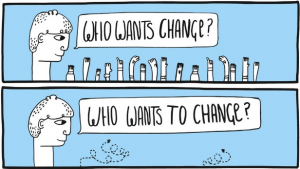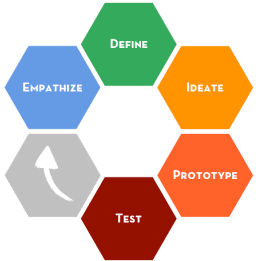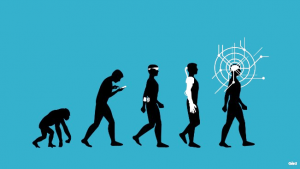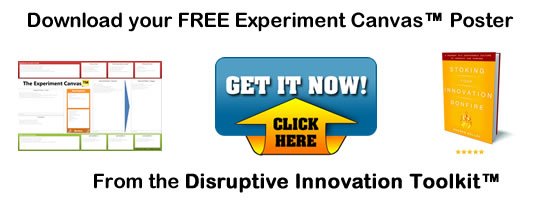A Wishlist of Innovation Mindsets
A few years back I published an article on LinkedIn on the The 7 Magic Roles for Creating Sustainable Innovation Culture based on my experiences in working for, building and putting to work effective innovation teams. What dawned on me recently is that what made those teams effective (or not) was not so much the roles that we established and filled but rather the mindsets they exhibited:
Innovation mindsets seem to unify the skills and competencies that individual innovation team members bring to the table as well as amplify the resilience and perseverance that all changemakers are dependent on.
Moreover, what also became clear is that an innovation team can only serve as a catalyst to the larger organization in creating an effective and sustainable culture of innovation. While innovation teams can serve in creating tangible innovation success by focusing on the execution of definable innovation priorities, the transformation of an organization into one that is able to continuously reinvent itself in anticipation of changing trends and environments requires a more comprehensive and broader approach to innovation throughout the organization. Consequently, the following wishlist of innovation mindsets does not only apply to innovation team members but employees at innovative organizations in general.
Interaction Mindset
Curiosity
 Innovation never stands still. The market environment, enabling technologies, customer preferences and attitudes, partner priorities, and internal corporate politics are a dynamic system creating everchanging impulses, opportunities and challenges. Being able to understand these dynamics, to learn how to effectively navigate them and to adapt appropriately in the quest for driving innovation progress requires a significant amount of curiosity in the unknown – and the willingness to
Innovation never stands still. The market environment, enabling technologies, customer preferences and attitudes, partner priorities, and internal corporate politics are a dynamic system creating everchanging impulses, opportunities and challenges. Being able to understand these dynamics, to learn how to effectively navigate them and to adapt appropriately in the quest for driving innovation progress requires a significant amount of curiosity in the unknown – and the willingness to
make the exploration of the unknown a habit rather than a periodic exercise.
Relationship building
Every member of an innovation team – in addition to the specific tasks of their role – must contribute to evangelizing innovation throughout their organization. Innovation is never well understood throughout, its definition is fuzzy and depends on who you talk to, its role in the organization is constantly under scrutiny and its value proposition to each internal stakeholder is one that needs to be developed through collaboration, advocated for and proven. It requires much EQ, tact, people skills and positive energy to be such evangelist while preaching and patronage will result in deceiving lip service in support of innovation, if not resistance and adversarial behaviors.
People Mindset
Active listening and Appreciative Inquiry

Before Design Thinking there was Appreciate Inquiry (AI). It is a change management approach rooted in the belief that it is much more effective building upon strengths than to eliminate weaknesses. For any defined focus area, AI follows a process of inquiry, discovery, ideation & storytelling, design, co-creation and innovation delivery, thus fueling innovation with the energy surrounding positivity and appreciation of what’s working. The conversations throughout this process, however, unearth ultimately the passions, dreams, pains and drivers of involved stakeholders, who are eager to share. Actively listening and reading between the lines greatly allows for deeply understanding and consequently empathizing with the various stakeholders. This technique doesn’t only work for innovation and thus is such an important skill for innovation team members to possess. Yet, it is equally effective for general human interaction. Why don’t you try it with that annoying team member of yours? Or why not exploring it even further with your partner at home? You might sleep on the couch again – but you would finally appreciate why …
Actively listening and reading between the lines greatly allows for deeply understanding and consequently empathizing with the various stakeholders.
Behavioral Economics
 Ever wondered why you are not getting through to people? Why that tested, great idea still doesn’t get traction? Well, it’s because people are not rational beings. They are driven by needs, desires, and ambitions that are much more primal than improving the corporate products and services beyond the status quo. In a corporate setting, they are dominated by self-actualization at the tip of Maslow’s Hierarchy of Needs, which can be even further decoded when looking at self-determination theory and positive psychology. The good news is that by understanding the different motivations of your counterparts, even this irrationality can become predictable. The body of research associated to it is called Behavioral Economics and is being exploited especially by the marketing community for years. So, check it out – it might also change your life through self-discovery.
Ever wondered why you are not getting through to people? Why that tested, great idea still doesn’t get traction? Well, it’s because people are not rational beings. They are driven by needs, desires, and ambitions that are much more primal than improving the corporate products and services beyond the status quo. In a corporate setting, they are dominated by self-actualization at the tip of Maslow’s Hierarchy of Needs, which can be even further decoded when looking at self-determination theory and positive psychology. The good news is that by understanding the different motivations of your counterparts, even this irrationality can become predictable. The body of research associated to it is called Behavioral Economics and is being exploited especially by the marketing community for years. So, check it out – it might also change your life through self-discovery.
Process Mindset
Towards creative problem solving
  All of those great innovation tools and techniques available – enabling us to create massive amounts of cool ideas through divergence, evaluating candidate ideas and converging towards the best candidates…
 All of those great innovation tools and techniques available – enabling us to create massive amounts of cool ideas through divergence, evaluating candidate ideas and converging towards the best candidates…
Unfortunately, they often lead to far too many ideas, paralysis in the evaluation phase and a convergence towards merely a slightly different variant of what was there before. All this creativity has little chance of success if it is not preceded by two crucial steps in problem solving:
A thorough root cause analysis and the willingness to challenge established assumptions are prerequisites to framing the problem to be solved.
The latter is truly a frame of mind and while all the other components, techniques and tools can be learned and trained, it is the willingness to challenge assumptions and the ability to engage others in doing so, that makes innovation team members extra special.
Generalized Design Thinking
 Design Thinking has over the past few years taken the innovation community by storm although the process of specifying a problem, ideating around solutions, prototyping and testing those – rapidly and iteratively – is truly not that new. What makes it possibly different is that it explicitly requires empathizing with the target audience up front, that it positions desirability before feasibility and viability assessments. So, having innovation team members that embrace design thinking from the perspective of thinking about the needs, tasks, pains and dreams of others first, and who are willing to apply creative problem solving through rapid iterations of experimenting and testing goes beyond innovation. It is a prerequisite for continuous improvement in general.
Design Thinking has over the past few years taken the innovation community by storm although the process of specifying a problem, ideating around solutions, prototyping and testing those – rapidly and iteratively – is truly not that new. What makes it possibly different is that it explicitly requires empathizing with the target audience up front, that it positions desirability before feasibility and viability assessments. So, having innovation team members that embrace design thinking from the perspective of thinking about the needs, tasks, pains and dreams of others first, and who are willing to apply creative problem solving through rapid iterations of experimenting and testing goes beyond innovation. It is a prerequisite for continuous improvement in general.
Technology Mindset
Digital Citizenship
 While innovation is not about technology, technology plays a significant role in supporting personalization, scale, distribution, and affordability of access for new value propositions. Consequently, innovation team members in their role as advocates need to be able to find the balance between the distracting technology hype that comes with the rapid speed of technological innovation, and the pragmatic rationality of UX design that emphasizes usefulness, utility and use of technological products and services. In this role, it is unacceptable if one has only passing familiarity with productivity tools such as Office or Email, uses hearsay to recite the opportunities and risk of using social media, is ignorant towards digital communication etiquette, or unaware of forming Boolean queries for Internet searches. How can we expect for our stakeholders to embrace new value propositions by adopting new technologies if we ourselves use last decades’ technologies ineffectively and haphazardly? More importantly, insufficient digital literacy reflects a lack of curiosity, disinterest to explore, inability to learn new things, and inflexibility to change one’s own habits. Those are attitudes that have no place in an innovation team.
While innovation is not about technology, technology plays a significant role in supporting personalization, scale, distribution, and affordability of access for new value propositions. Consequently, innovation team members in their role as advocates need to be able to find the balance between the distracting technology hype that comes with the rapid speed of technological innovation, and the pragmatic rationality of UX design that emphasizes usefulness, utility and use of technological products and services. In this role, it is unacceptable if one has only passing familiarity with productivity tools such as Office or Email, uses hearsay to recite the opportunities and risk of using social media, is ignorant towards digital communication etiquette, or unaware of forming Boolean queries for Internet searches. How can we expect for our stakeholders to embrace new value propositions by adopting new technologies if we ourselves use last decades’ technologies ineffectively and haphazardly? More importantly, insufficient digital literacy reflects a lack of curiosity, disinterest to explore, inability to learn new things, and inflexibility to change one’s own habits. Those are attitudes that have no place in an innovation team.
Innovation team members must be digital citizens in nature and must ensure they continually maintain and develop this status.
Insight literacy
 While insight literacy is certainly part of digital citizenship, for innovation it is so crucial that it is worth an additional mention. Creating Insight is at the root of an effective innovation process, which ultimately amounts to effectively analyzing and communicating with data and information collected on customer needs, market trends, technology opportunities and risks, innovation metrics, business KPIs, etc. Data surrounds us and drives our decisions (or so it should) on a daily basis and wherever we are, and everybody owns and touches certain data and information. Like reading and writing in past centuries, by now data literacy divides the world into the haves and have nots. For innovation team members, embracing data and information as the prerequisite fuel to creating insights, learning to use existing new tools for data analysis by non-data scientists, prioritizing information design and visualization as a means for effective communication as well as telling stories with data, those are skills that have become indispensable for carrying the torch of innovation through an organization.
While insight literacy is certainly part of digital citizenship, for innovation it is so crucial that it is worth an additional mention. Creating Insight is at the root of an effective innovation process, which ultimately amounts to effectively analyzing and communicating with data and information collected on customer needs, market trends, technology opportunities and risks, innovation metrics, business KPIs, etc. Data surrounds us and drives our decisions (or so it should) on a daily basis and wherever we are, and everybody owns and touches certain data and information. Like reading and writing in past centuries, by now data literacy divides the world into the haves and have nots. For innovation team members, embracing data and information as the prerequisite fuel to creating insights, learning to use existing new tools for data analysis by non-data scientists, prioritizing information design and visualization as a means for effective communication as well as telling stories with data, those are skills that have become indispensable for carrying the torch of innovation through an organization.
Are you in the right mindset to lead innovation and change?
Wait! Before you go…
Choose how you want the latest innovation content delivered to you:
- Daily — RSS Feed — Email — Twitter — Facebook — Linkedin Today
- Weekly — Email Newsletter — Free Magazine — Linkedin Group
[author image=”https://www.disruptorleague.com/wp-content/uploads/2018/02/LME-6C-sm.jpg”]Dr. L. Miguel Encarnação is a corporate innovation orchestrator and executive management consultant who has held executive innovation leadership positions across industries for the past 20 years. Towards pursuing a strategic systems approach to sustainable innovation, he combines thought leadership in developing corporate innovation cultures with deep technical expertise in emerging technologies . He is a frequent keynote speaker, educator, and author as well as adjunct professor of computer science. You can connect to him through his LinkedIn profile and follow him on Twitter @mencarna.[/author]
NEVER MISS ANOTHER NEWSLETTER!
LATEST BLOGS
How Brexit Has Affected UK E-commerce Businesses
Photo by Zyro on Unsplash The popularity of online shopping was already growing at an impressive rate – and…
Read MoreOvercoming range anxiety: three tips for EV owners
Photo by Jenny Ueberberg on Unsplash In the last few years, electric vehicles (EVs) have become more and more…
Read More


